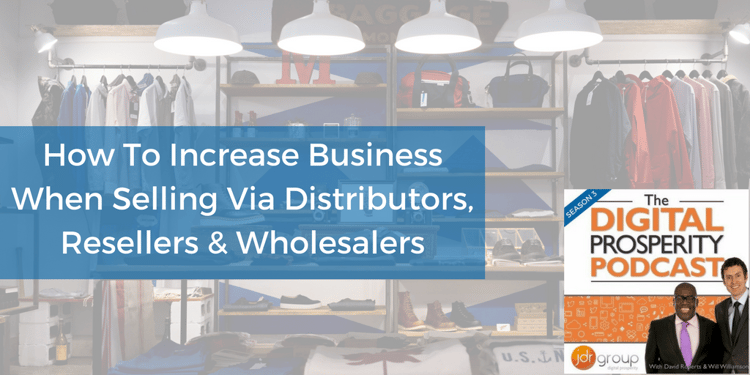How To Increase Business When Selling Via Distributors, Resellers & Wholesalers - Season 3, Episode 3 Of The Digital Prosperity Podcast

Selling via distributors, resellers and wholesalers is a common business model. I was with a client yesterday who relies on sales via distributors and this is a challenge we’ve come across over the years many, many times. If other people are selling your products for you, this can be a really good model because if you find just a few good accounts, it can lead to years and years of high revenue. Your resellers, your distributors, your wholesalers, they deal with all of the marketing, all of the questions that people get and all of the customer service.
They deal with all the invoicing, the deliveries. They deal with all the marketing and you just provide the product to them. As long as you do a good service and you provide a good product, then you should be able to rely on years and years of good income from just a few good accounts.
What's The Challenge With This Business Model?
The challenge is you’re not dealing with the end customer. You’re not in charge of the selling. You’re not in control of how your products are marketed and sold to the end user.
It effectively means that you’re reliant on someone else to do your selling for you. Now, that’s great as long as it’s going well. But if the sales drop, then you have a problem and it can be harder in this type of business model to grow the company.
What Can You Do To Increase Your Business If You Have This Type Of Business Model?
Well firstly, let’s start by taking a look at the products themselves that you sell. That’s always the starting point in my view. Can you add new lines? Can you develop existing lines to make your products more attractive? Ultimately, the reason why your distributors may not be selling as much as you would like them to might be that other competitive products are more attractive or appear more attractive to the end user and they want to retain their customers. So if other people choose competitive products over yours, they’re not going to complain. Either way, they make the sale.
So if you have a better product, you should get better sales. But also it could be that your distributors make better margins selling your competitor’s products. So if your sales drop via resellers, distributors, wholesalers, while you’ve always enjoyed good sales previously, it’s really important to spend time with your customers, trying to understand why that has happened.
Market Research
You might want to invest in market research to the end user, to understand the perceptions of your products and understand why people are choosing competitive products, if that is what is happening. So we start there.
Open New Accounts
Now, another thing that you can do is to look to simply open new accounts. If you have, let’s say, 30 resellers and distributors and that account is for all your revenue and if their revenue drops because they are not selling as much as you would like, it’s just static and you want to grow, then simply go to 35, 40, 50 accounts. So have a look for the accounts that you haven’t opened, that you may well be able to open. This could mean looking at different regions, different locations or it could mean being creative. Just like if you take the coffee brands like Costa and Starbucks, they are not just selling via their retail stores now. They’re in other people’s stores. They’re in garages. They’re in theatres even. They’ve got concessions in several different places. They found other places where they can sell their products. So open new accounts.
Provide Support & Content
Now that may not be possible. You might have a fairly high saturation level in your customers.
So one thing you want to do is to provide marketing support to your distributors, to provide content that they can use to help market and sell your products. For example, you might want to produce a database of all of your products with the prices, descriptions, the part numbers, and an image file. So that if any of your distributors or resellers want to sell the products online via e-commerce, you can simply send them this database file and they can just upload it to their website and make it really easy for them to be able to sell your products online.
Other content could include technical data sheets. You might want to invest in a video that promotes the products that makes it easy for them to embed or share those videos to promote the products themselves. You might want to invest in point of sale. You might want to invest in market research or independent research that proves how good your products are. Tests where you run your product against a competitor’s product that proves how much better yours is. That content then – your customers can use to sell to their customers.
Demand Based Marketing Campaigns
You could run demand-based marketing campaigns. So these are campaigns that are designed to promote your brand, to promote your products to the end users. In other words, to try and create awareness of your products and services, to drive demand so that the end users demand the products from your resellers, distributors, and wholesalers.
Driving More Traffic
You might want to start a blog where you create regular content that announces new products, new promotions, and that just generally promotes your products. This can help drive traffic to your website.
If you are running pay-per-click advertising or blogging using social media, you’re driving traffic to your website. This can be a big boost for your brand. It creates awareness and it drives traffic, which then you can use as evidence when you want to open new accounts.
So if you’re talking to a potential new distributor, you can tell them how many people visit your website, how many people search for your products and you can also generate enquiries from the end users that are actually looking to purchase the products and pass these on to your customers.
Promotions
Finally, you could agree on and run promotions. So you can look to run short-term offers that drive demand and while you don’t want to be doing that all the time, some kind of short-term incentives can lead to people buying new products for the first time, which can ultimately change their long term buying habits.
Consider Selling Directly?
Now finally, if all of this doesn’t have the impact that you wanted to in terms of your business growth, you may well want to consider selling directly. In other words, opening your own store or your own online store where you can sell direct to the end user and bypass those distributors. You may run the two things alongside each other, continue to sell to the distributors, resellers and to sell directly to the public. Lots of companies do this.
Nike has a range of their own retail stores as well as selling via distributors and wholesalers, etc. The same thing with Apple. So plenty of big brands do this and in the software industry, plenty of software companies sell their software products directly to the end user. But they also sell via resellers and third parties.
So it’s more than possible to run both models. But it can be risky because you can upset existing customers when you do it. So there are two approaches. One is to hide it from them by launching this new company as a brand new brand with a completely different company name that’s completely unlinked to your brand.
Now, that can keep it quiet and it can mean that your customers don’t find out about it or at least not quickly. It gives you time to let it grow and build. However, you’re also starting a brand new business and you’re starting effectively from square one. So that can have limited effect.
The other approach is to actually start selling directly via your main company website. In which case, it will be there for everyone to see and you will need to tell your customers that that’s what you’re doing. Now, a couple of ways to minimise the potential risk there are to only sell in regions which are not covered by your distributors or wholesalers.
So I’ve had this conversation with a company that provides motoring products where motor factors sell their products to garages. Well, they only have motor factors in certain towns in the country and there are whole stretches of the UK that have no coverage.
So it’s perfectly reasonable for them to be able to sell online to reach the garages that don’t have a local motor factor stocking their products and your customers would be reasonable and understand that. The other thing is that customers would get unhappy were you to undercut them.
So if you communicate that you’re not going to undercut them, you’re going to sell at the same price that you recommend they sell at, then you can minimise the resistance to you taking this approach.
Summary
So it can be risky but there’s also a big, big upside if you can get it to work well and you can take a bit more control over the sales of your products. So in conclusion, you can open new accounts. You can drive demand and you can invest in content that your customers can then use. You can cut out the middle man and you can sell direct and you can run offers and promotions.
Now if you would like to know more about offers and promotions, we have a free resource which you can download directly from our website.
If you go to - www.jdrgroup.co.uk
Go to the Resources tab on the top and go down to Free Guides. You will see the ultimate guide to special offers and promotions. You can download this for free and it covers everything you need to know about running offers and promotions via your website that can help drive demand and drive sales and generate leads. Or click on this link… https://offers.jdrgroup.co.uk/how-to-create-the-ultimate-special-offer-for-lead-generation


